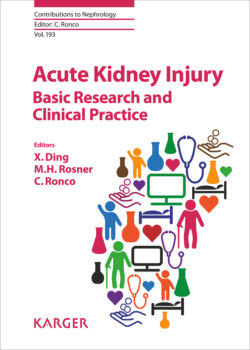Читать книгу Acute Kidney Injury - Basic Research and Clinical Practice - Группа авторов - Страница 46
На сайте Литреса книга снята с продажи.
Subclinical AKI: Dysfunction or Injury?
ОглавлениеClearly there is now a significant body of literature that has investigated AKI biomarkers in a variety of clinical settings and in diverse patient groups. However, there remains an almost slavish addiction to highlighting the performance of AKI biomarkers to predict AKI defined by the classical parameters. Although this is clearly of interest, one must also question what message these biomarkers are telling us if any. Figure 2 highlights some theoretical scenarios where a biomarker associated with AKI may inform us above and beyond that of the SCr. For example, in a previously healthy individual with “normal” renal function, a significant tubular injury may occur undetected if one relies solely on the SCr as a marker of AKI, whereas employing urine output criteria in isolation may result in misclassification of AKI. Under both conditions, a biomarker of AKI may inform beyond that of the SCr and urine output particularly where renal dysfunction rather than true damage has occurred. Therefore, AKI biomarkers may allow a diagnosis of AKI to be made earlier but also indicate where renal injury has occurred even in the absence of subsequent dysfunction [49]. This concept of sub-clinical or silent AKI implies that although AKI may not clinically manifest, it has occurred but has escaped detection by conventional means. This requires a shift in approach from a predictive role of the AKI biomarker to that of a diagnostic or indeed prognostic tool. Coupled with this would be the acceptance that acknowledging such “biomarker positivity” or subclinical (silent) AKI would reflect on the epidemiology of AKI as well as affect the management of patients and perhaps result in better outcomes. However, this approach implies that the presence of a positive biomarker may result in poorer outcomes. Indeed there is evidence that this is the case. For example, a pooled analysis on over 2,000 patients with cardiorenal syndrome examined both plasma and urinary NGAL. Patients were classified as NGAL+ve or NGAL–ve according to the study specific cut-offs for AKI prediction as well as SCr+ve or SCr–ve according to conventional AKI criteria [50]. Over 19% of study patients were NGAL+ve/SCr–ve and this group had a higher observed in-hospital mortality when compared to NGAL–ve/SCr+ve (12.4 vs. 8.4%). In all groups, there were incremental increased risks associated with biomarker positivity including length of both ICU and hospital stay and requirement for renal replacement therapy. Interestingly in this cohort, both plasma and urinary NGAL conferred an increased risk. Whatever the mechanism, there is a clear signal that the presence of markers associated with renal injury confer an increased risk for relevant clinical endpoints and as such should not be ignored. With the future increase in the number of potential AKI biomarkers, it may be that a combination will provide much more timely information regarding pathophysiology and outcomes rather than simply predicting a rise in conventional markers of renal function.
Fig. 2. Subclinical acute kidney injury (AKI). Three scenarios are depicted, which may highlight the clinical use of AKI biomarkers over and above the prediction of AKI stage. Subject A has normal renal function with a significant renal reserve. Despite a fall in glomerular filtration rate (GFR) by about 40%, the rise in serum creatinine (SCr) does not reach the diagnostic threshold for AKI, but the subject has a positive biomarker in keeping with significant tubular damage and subclinical AKI. In case B, there is a much smaller fall in GFR (and significantly reduced renal reserve) and following insult a small fall in GFR translates to AKI stage 1. Under certain circumstances, the biomarker may be negative such as following administration of drugs that interfere with creatinine tubular secretion. Case C highlights a scenario where the urine output criteria for AKI are satisfied, but the biomarker is not elevated. This may represent physiological oliguria following major surgery, for example.
